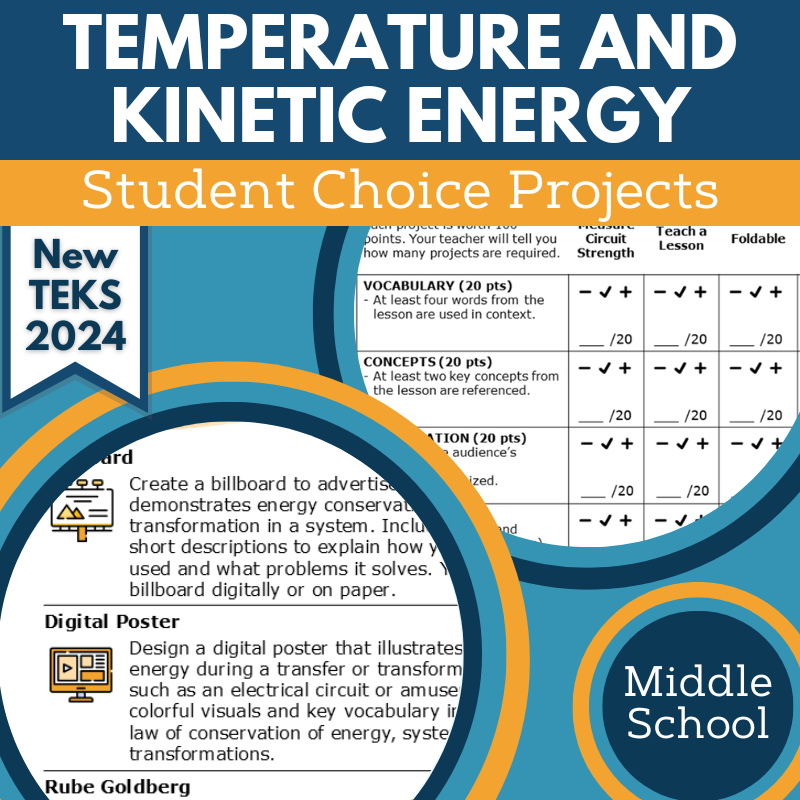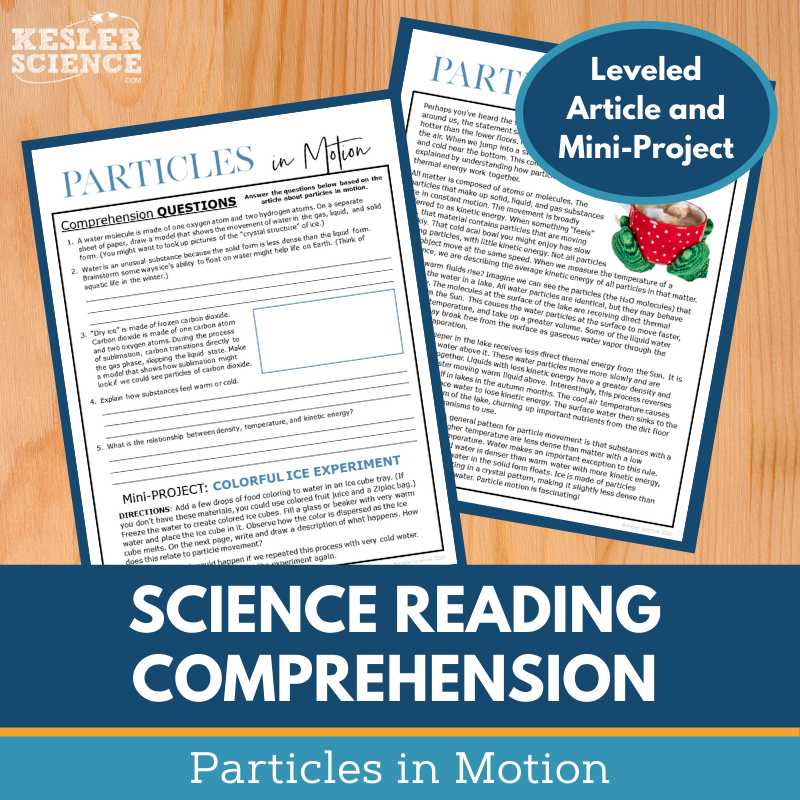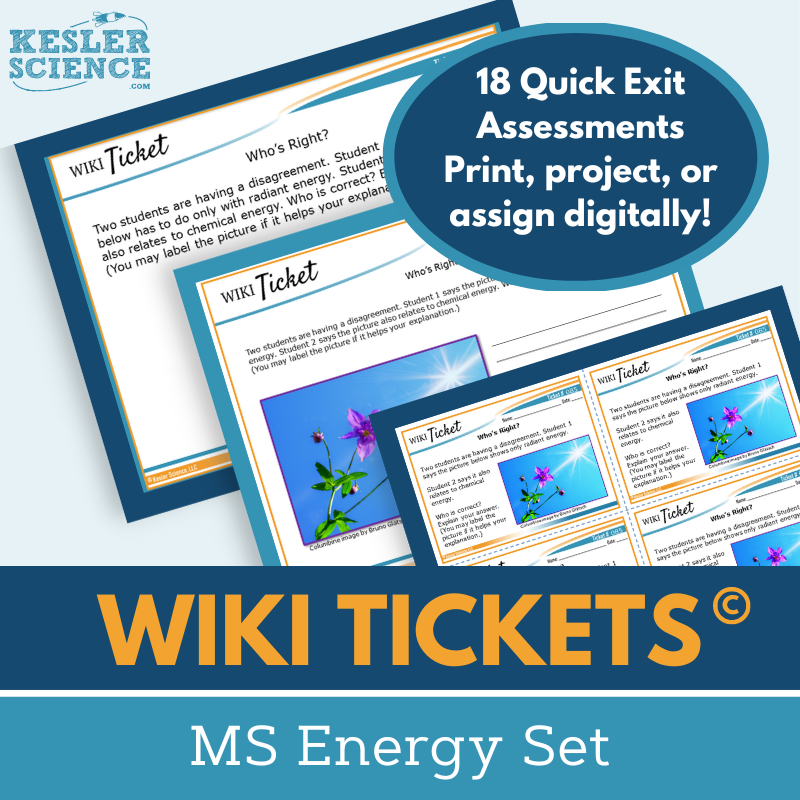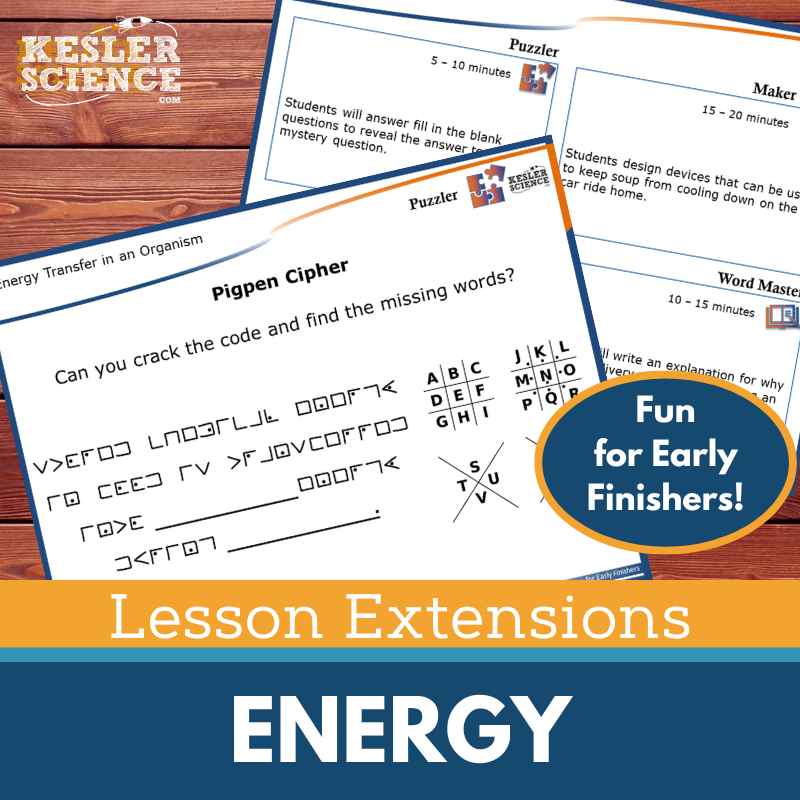Temperature & Kinetic Energy Activities for Middle School Science
Explore the relationship between temperature and kinetic energy with this engaging middle school lesson. The resources below will give students a comprehensive understanding of temperature and kinetic energy. All of the following materials are also included in the Kesler Science Membership.
The Kesler Science Temperature & Kinetic Energy 5E Lesson is a comprehensive middle school unit exploring the relationship between temperature and the kinetic energy of particles. It includes editable presentations, worksheets, assessments, and student-choice projects designed for differentiated, student-led learning. The lesson requires low to no prep and is available in both digital and printable formats, making it flexible for any classroom setting. Spanish translations are provided for vocabulary, station lab reading passages, and interactive notebook pages.
Following the 5E Model, students engage through word wall cards and discussion activities before exploring the kinetic theory of matter in a hands-on, differentiated station lab. The lab includes multimodal input and output stations, allowing students to experiment, read, research, watch videos, categorize information, write, illustrate, and assess their understanding. A bonus challenge station extends learning for early finishers.
Explanation materials include editable PowerPoints, interactive notebooks, and note-taking templates. Students elaborate through choice projects, while evaluation resources feature STAAR 2.0-aligned assessments, review questions, and worksheets for discussion or homework. Designed for maximum flexibility, this lesson supports both in-class and virtual learning, ensuring accessibility for all students.
The Kesler Science Temperature & Kinetic Energy 5E Lesson is a comprehensive middle school unit exploring the relationship between temperature and the kinetic energy of particles. It includes editable presentations, worksheets, assessments, and student-choice projects designed for differentiated, student-led learning. The lesson requires low to no prep and is available in both digital and printable formats, making it flexible for any classroom setting. Spanish translations are provided for vocabulary, station lab reading passages, and interactive notebook pages.
Following the 5E Model, students engage through word wall cards and discussion activities before exploring the kinetic theory of matter in a hands-on, differentiated station lab. The lab includes multimodal input and output stations, allowing students to experiment, read, research, watch videos, categorize information, write, illustrate, and assess their understanding. A bonus challenge station extends learning for early finishers.
Explanation materials include editable PowerPoints, interactive notebooks, and note-taking templates. Students elaborate through choice projects, while evaluation resources feature STAAR 2.0-aligned assessments, review questions, and worksheets for discussion or homework. Designed for maximum flexibility, this lesson supports both in-class and virtual learning, ensuring accessibility for all students.
Engage your middle school students with this student-led station lab aligned with TEKS 7.8C, exploring the relationship between temperature and kinetic energy. Designed for in-class or virtual learning, this interactive lesson allows students to direct their own learning through nine differentiated stations featuring videos, readings, research, and hands-on activities.
Students engage with new concepts through multimodal input stations, including demonstrations, video analysis, reading comprehension, and research tasks. They then showcase their understanding through output stations, where they organize information, illustrate models, respond to prompts, and complete assessments. A bonus challenge station offers extension activities for advanced learners.
This low-prep, high-engagement resource fosters critical thinking and active learning in physical science.
Engage your middle school students with this student-led station lab aligned with TEKS 7.8C, exploring the relationship between temperature and kinetic energy. Designed for in-class or virtual learning, this interactive lesson allows students to direct their own learning through nine differentiated stations featuring videos, readings, research, and hands-on activities.
Students engage with new concepts through multimodal input stations, including demonstrations, video analysis, reading comprehension, and research tasks. They then showcase their understanding through output stations, where they organize information, illustrate models, respond to prompts, and complete assessments. A bonus challenge station offers extension activities for advanced learners.
This low-prep, high-engagement resource fosters critical thinking and active learning in physical science.
The Temperature & Kinetic Energy Student Choice Projects align with the 2021 TEKS standard 7.8C, offering middle school students a variety of project options to demonstrate their understanding. A project page outlines six student-led choices plus a “design your own” project, with an editable rubric for teacher, peer, or self-assessment.
These flexible, multimodal projects allow for creative and personalized learning experiences. Two versions of the project page provide differentiation, with modified options for students needing remediation and challenge opportunities for advanced learners. Teachers can adjust the rubric to fit grading needs.
The projects require standard classroom supplies such as paper, markers, and scissors, with many options available for digital completion.
The Temperature & Kinetic Energy Student Choice Projects align with the 2021 TEKS standard 7.8C, offering middle school students a variety of project options to demonstrate their understanding. A project page outlines six student-led choices plus a “design your own” project, with an editable rubric for teacher, peer, or self-assessment.
These flexible, multimodal projects allow for creative and personalized learning experiences. Two versions of the project page provide differentiation, with modified options for students needing remediation and challenge opportunities for advanced learners. Teachers can adjust the rubric to fit grading needs.
The projects require standard classroom supplies such as paper, markers, and scissors, with many options available for digital completion.
This Science Reading Comprehension Passage helps students explore changes in particle motion, temperature, and state when thermal energy is added or removed. Students read a nonfiction article about particles in motion, answer comprehension questions, and conduct a colorful ice experiment.
Designed for grades 6-8 (with higher-level 5th graders in mind), the resource includes two leveled articles (Lexile 1100-1300), five to seven comprehension questions, and a hands-on mini-project. A Cornell notes template is provided, along with engaging graphics that print well in grayscale.
The passage can be used for virtual or in-person learning and is compatible with platforms like Google Classroom, MS Teams, Schoology, and Canvas. Students can respond directly in the included PPT or Google Slides. Ideal for sub plans, extra credit, ISS, or whole-class instruction, this resource builds science literacy, supports textual analysis, and encourages classroom discussions.
This Science Reading Comprehension Passage helps students explore changes in particle motion, temperature, and state when thermal energy is added or removed. Students read a nonfiction article about particles in motion, answer comprehension questions, and conduct a colorful ice experiment.
Designed for grades 6-8 (with higher-level 5th graders in mind), the resource includes two leveled articles (Lexile 1100-1300), five to seven comprehension questions, and a hands-on mini-project. A Cornell notes template is provided, along with engaging graphics that print well in grayscale.
The passage can be used for virtual or in-person learning and is compatible with platforms like Google Classroom, MS Teams, Schoology, and Canvas. Students can respond directly in the included PPT or Google Slides. Ideal for sub plans, extra credit, ISS, or whole-class instruction, this resource builds science literacy, supports textual analysis, and encourages classroom discussions.
The Thermal Energy and Molecules Science Writing Prompt Activity engages middle school students in a compare-and-contrast essay to reinforce their understanding of physical science concepts. Designed to enhance science reasoning and writing skills, this low-prep, student-centered activity supports both in-person and virtual learning.
Aligned with NGSS MS PS1-4, this activity helps students develop models predicting changes in particle motion, temperature, and state when thermal energy is added or removed. The resource includes teacher directions with answer guides, project ideas, and rubrics; projection and print handouts with pre-writing strategies and templates; half-sheet handouts for interactive notebooks; and a digital PowerPoint version for Google Slides.
Ideal for cross-curricular integration, pre-test assessments, student choice projects, early finisher enrichment, extra credit, make-up work, and differentiation, this writing prompt fosters engagement and critical thinking. It also works well for TELPAS samples and can be displayed on bulletin boards or compiled into student anthologies. Designed for review, it assumes students have prior knowledge or access to research materials.
The Thermal Energy and Molecules Science Writing Prompt Activity engages middle school students in a compare-and-contrast essay to reinforce their understanding of physical science concepts. Designed to enhance science reasoning and writing skills, this low-prep, student-centered activity supports both in-person and virtual learning.
Aligned with NGSS MS PS1-4, this activity helps students develop models predicting changes in particle motion, temperature, and state when thermal energy is added or removed. The resource includes teacher directions with answer guides, project ideas, and rubrics; projection and print handouts with pre-writing strategies and templates; half-sheet handouts for interactive notebooks; and a digital PowerPoint version for Google Slides.
Ideal for cross-curricular integration, pre-test assessments, student choice projects, early finisher enrichment, extra credit, make-up work, and differentiation, this writing prompt fosters engagement and critical thinking. It also works well for TELPAS samples and can be displayed on bulletin boards or compiled into student anthologies. Designed for review, it assumes students have prior knowledge or access to research materials.
The WIKI Tickets© Energy Set provides engaging formative assessments for 6th-8th grade science, offering flexible ways to check student understanding. This set includes 18 topics, each available in five formats: a full-screen projection version, three printable handouts in varying sizes, and an interactive digital version compatible with PowerPoint and Google Slides.
Aligned with NGSS and TEKS standards, these assessments ensure comprehensive coverage, with at least one ticket per standard. A bonus table of contents file is included for easy alignment reference. Designed for both in-person and virtual learning, WIKI Tickets© can be used as exit tickets, bellringers, or quick checks. Topics covered include energy transformations, heat transfer, kinetic and potential energy, wave characteristics, and more. Whether projected, printed, or assigned digitally, these engaging assessments help gauge student progress effectively.
The WIKI Tickets© Energy Set provides engaging formative assessments for 6th-8th grade science, offering flexible ways to check student understanding. This set includes 18 topics, each available in five formats: a full-screen projection version, three printable handouts in varying sizes, and an interactive digital version compatible with PowerPoint and Google Slides.
Aligned with NGSS and TEKS standards, these assessments ensure comprehensive coverage, with at least one ticket per standard. A bonus Table of Contents file is included for easy alignment reference. Designed for both in-person and virtual learning, WIKI Tickets© can be used as exit tickets, bellringers, or quick checks. Topics covered include energy transformations, heat transfer, kinetic and potential energy, wave characteristics, and more. Whether projected, printed, or assigned digitally, these engaging assessments help gauge student progress effectively.
Lesson Extensions provide engaging, student-choice activities designed to challenge early finishers and deepen their understanding of energy standards. These activities help fill downtime, reinforce critical thinking, and keep students engaged with rigorous yet enjoyable learning opportunities. Aligned to NGSS and TEKS, they offer flexible, high-level resources that support independent learning and enrichment.
Each extension includes four interactive components: Puzzler for problem-solving, Maker Space for hands-on STEAM activities, Tech Connection for digital demonstrations, and Word Master for creative writing. With teacher directions, answer keys, and both print and projection versions, these extensions are perfect for lesson wrap-ups, enrichment, or independent challenges, ensuring that students remain engaged and learning at a deeper level.
Topics covered include energy-related concepts such as amplitude and energy, digital vs. analog signals, electromagnetic spectrum, energy transformations, kinetic and potential energy, thermal energy transfer, photosynthesis, and more.
Lesson Extensions provide engaging, student-choice activities designed to challenge early finishers and deepen their understanding of energy standards. These activities help fill downtime, reinforce critical thinking, and keep students engaged with rigorous yet enjoyable learning opportunities. Aligned to NGSS and TEKS, they offer flexible, high-level resources that support independent learning and enrichment.
Each extension includes four interactive components: Puzzler for problem-solving, Maker Space for hands-on STEAM activities, Tech Connection for digital demonstrations, and Word Master for creative writing. With teacher directions, answer keys, and both print and projection versions, these extensions are perfect for lesson wrap-ups, enrichment, or independent challenges, ensuring that students remain engaged and learning at a deeper level.
Topics covered include energy-related concepts such as amplitude and energy, digital vs. analog signals, electromagnetic spectrum, energy transformations, kinetic and potential energy, thermal energy transfer, photosynthesis, and more.
Year-Round Resources
These year-round activities will increase your students' understanding of many middle school science topics. All of these activities are also included in the Kesler Science Membership.
Visual Data & Graphing
You're not alone if your students struggle with understanding graphs, charts, and tables. It's a skill that takes an enormous amount of practice. This resource will help students build a strong foundation in analyzing data and creating their own data visualizations.
Bell Ringers and Warm-Ups
These middle school science bell ringers are an excellent way to engage your students as soon as they walk into your classroom. This comprehensive FULL YEAR resource includes everything you need to start off each science class with an interesting warm-up activity.
Review Board Games
Each game board has been carefully designed to keep students engaged. There are 10 different action spaces on each board and dozens of question cards. All of the actions are related to science concepts and keep the students motivated throughout the game.
Each game is ready to play. Simply print out the board and the cards and let the students enjoy reviewing nine different units.
Essential Questions and Standards
Below are the essential questions and standards associated with the lessons and activities included in the atoms unit. This topic is only one of more than 100 middle school science topics included in the Kesler Science Membership.
-
What is the relationship between temperature and the kinetic energy of particles within a substance?
-
TEKS Science - 7.8C Temperature & Kinetic Energy
Kesler Science Membership
Imagine never having to search for another middle school science lesson again. The membership gives you access to ALL of the Kesler Science products in one place (Yes, including everything above).
Say goodbye to long hours of lesson prep.















